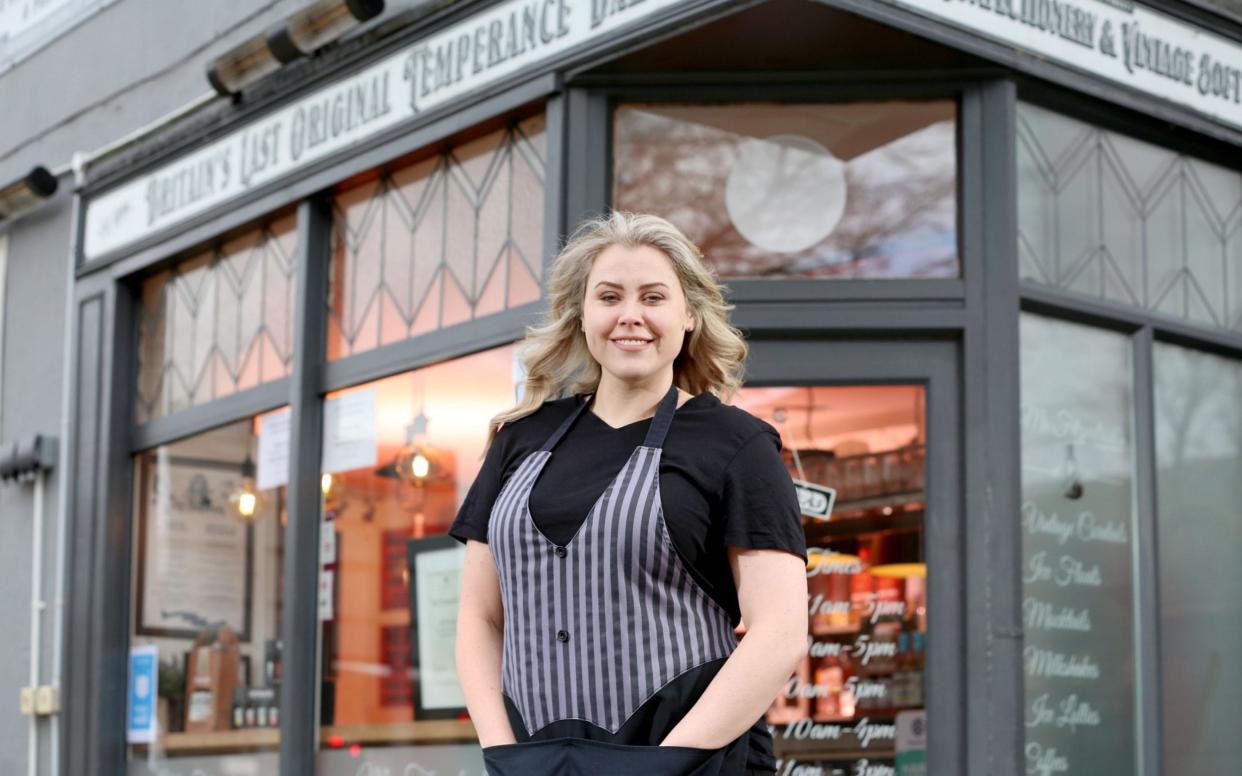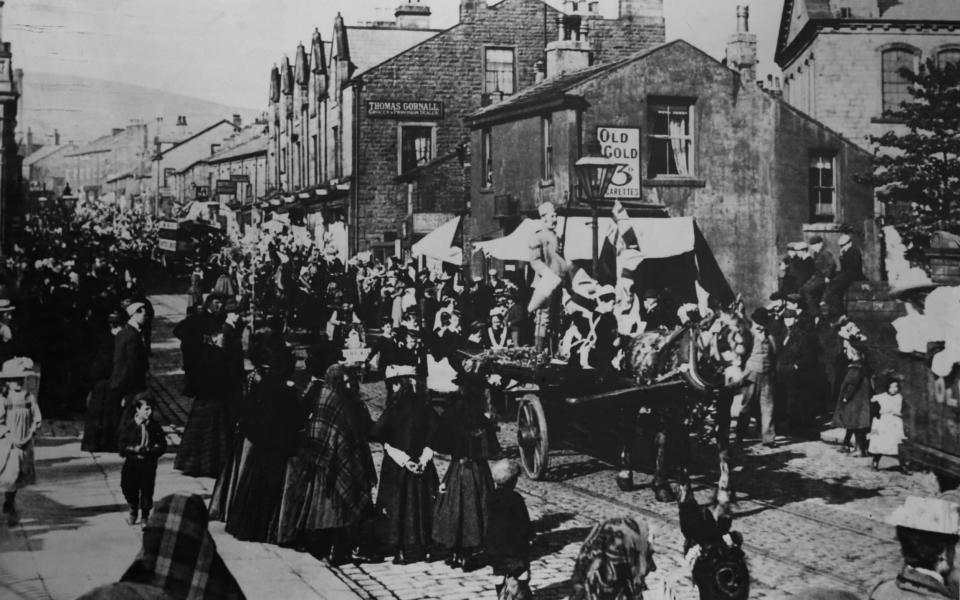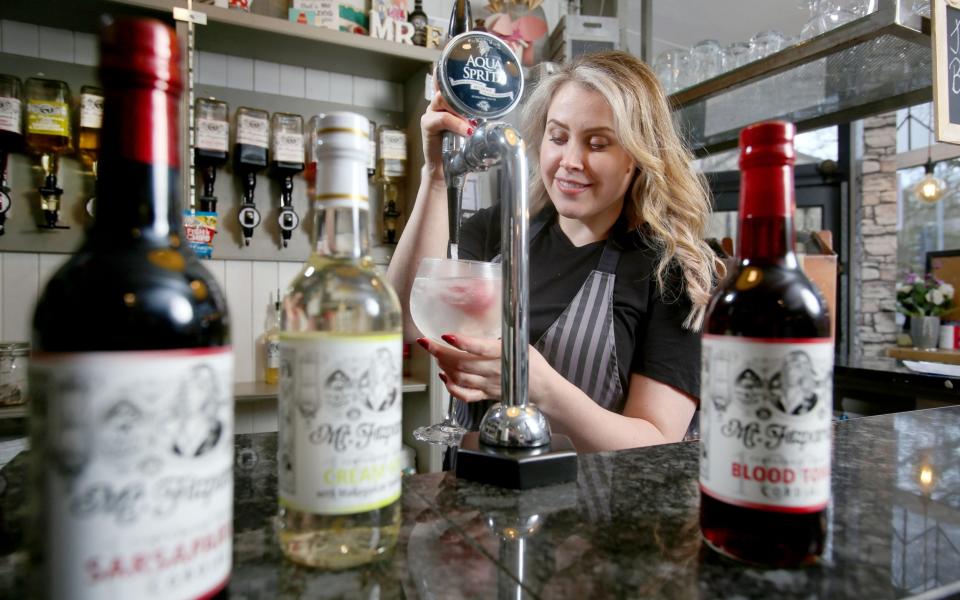Inside Britain’s last temperance bar – the first of a new brand of boozer

During its 122-year history, Mr Fitzpatrick’s bar in Rawtenstall has endured enough crises to turn many to drink – two world wars, the Spanish Flu pandemic, and now Covid, to name but a few. But with Britain’s hospitality trade tanking and many pubs closing their doors for good, spirits are still high at Britain’s last original temperance bar, which has stood on Bank Street in the Lancashire mill town since 1899.
Behind the bar and original stone fireplace are optics containing 29 flavours of home-made cordial: dandelion and burdock, cream soda, sarsaparilla and a curious concoction described as ‘blood tonic’. Due to being contractually obliged not to serve any alcohol on premises, owner Ashleigh Morley-Doidge has been able to stay open serving her soft drinks to take away during the pandemic.
And business, as it has been ever since she took the bar over five years ago, is good. Morley-Doidge’s family also operates a separate company brewing the cordials and now regularly supplies the US, the United Arab Emirates, Europe and Japan. Here as well, demand is on the rise. “It is really interesting to see how many people don’t drink alcohol and are looking for something unusual and different,” says the 35-year-old.
As the last man standing of the temperance bars that once proliferated across the country (and particularly the North) Mr Fitzpatrick’s remains something of a novelty in the modern era. But perhaps not for much longer.
As revealed in The Telegraph earlier this month, ministers are contemplating a temporary booze ban as part of the roadmap out of lockdown, with pubs and restaurants allowed to open even as soon as April, permitted they do not serve alcohol. The move is being discussed to allay concerns from chief medical officer Professor Chris Whitty and others about the effect of drinking on social distancing and to avoid last year’s chaotic scenes of ‘Super Saturday’ when pubs reopened after the first lockdown.
Whether or not this policy comes to pass, on a wider level the pandemic has reshaped our relationship with alcohol for better and worse. While drinking increased during lockdown, with many turning to it as a coping mechanism, experts believe that in the long term, pre-pandemic trends of abstinence – particularly among a younger generation – may be accelerated as we focus more on our health.
“This crisis is a bit like others where things don’t go back entirely to what they were like before but instead build on what was already happening,” says Virginia Berridge, professor of history and health policy at the London School of Hygiene and Tropical Medicine. “Pubs were already playing a much bigger role in serving non-alcoholic drinks and food. There has been a generational shift of people going to the pub for a convivial experience but not necessarily drinking huge amounts of alcohol.”
Mr Fitzpatrick’s Bar was one of 40 established across the North West by the Fitzpatrick family who moved from Dublin across the Irish Sea in 1899. By then the temperance movement was at its peak, the first temperance hotel having opened in nearby Preston in 1833 by local reformer Joseph Livesey who invented the phrase ‘teetotal’. Livesey also published England’s first temperance publication, The Moral Reformer, focusing on the impact of the ‘demon drink’ on the working classes.

The roots of the movement had started in the previous century when the Methodist preacher John Wesley was among those condemning the sale of spirits, which he described in one sermon as “liquid fire”. In 1751 the artist William Hogarth famously depicted widespread public drunkenness as a moral sink with his drawings Beer Street and Gin Lane.
According to Peter Forsaith, historian of religion, culture and society in 18th century Britain at Oxford Brookes University, initially the concern was just around spirits rather than giving up alcohol altogether. Poor quality tap water and a lack of pasteurised milk meant many people drank a low alcohol brew known as ‘small beer’ instead. Even Wesley drank alcohol in moderation, says Forsaith.
By the mid-19th century the temperance movement had started to sweep the country. In 1847 Reverend Jabez Tunnicliff founded the Band of Hope union. Three hundred children attended the first rally in Leeds, signing a pledge reading: ‘I the undersigned do agree that I will not use intoxicating liquors as a beverage’. By 1887, 1.5 million youngsters had subscribed, attracted by Sunday school outings and away days to the seaside. By the end of the century the Band of Hope had 3.25 million members.
Quakers and members of the Salvation Army also played an active role in trying to persuade the House of Commons to pass legislation to restrict the sale of alcohol. The Sally Army, as they were known, posted band members on street corners to perform songs from a temperance playlist. ‘There’s a demon in the glass: dash it down! Dash it down!’ was among the popular lyrics of the day.
The temperance movement was also one of the first ways in which women entered the political fray, says Berridge. The British Women’s Temperance Association was set up in 1876 and at its height in 1892 had 577 affiliated branches, with a total of 45,000 members

There was, she says, “a cult of respectability” which temperance tapped into among upper working class families as a means of personal improvement. The first excursion arranged by the travel agent Thomas Cook in 1841 was a return rail journey from Leicester to a temperance meeting in Loughborough. Jesse Boot, the founder of Boots the chemist, was another supporter of the movement.
It has been estimated that by 1900 about a tenth of the adult population were total abstainers from alcohol. Despite the waning popularity of the temperance movement in the early 20th century, the overall alcohol consumption among adults in Britain continued to decline. It was only in the late 1960s, with the rise of a new consumer generation, supermarkets and foreign holidays, that drinking started to steadily increase.
However in recent years there has been a marked drop, and particularly among the young. In 2017, 20 per cent of the population reported not drinking alcohol at all. Overall consumption has fallen by around 16 per cent since 2004. A 2018 study showed that 30 per cent of all 16-24 year olds do not drink.
According to Dr Emily Finch, vice chair of the addictions faculty at the Royal College of Psychiatrists, the way in which we drink is an increasingly divided picture between a more abstinent gen Z and millennials, and boozy baby boomers. This is a divide that has widened during lockdown but overall as a society, she says, “we have the opportunity to emerge as a healthier nation”.
Back at Mr Fitzpatrick’s bar, Morley-Doidge contrasts her customers today with when she was growing up in the town. “When we were young we got trollied because it was cool,” she says. Now she regularly gets teenagers and 20-somethings propping up the bar for a sarsaparilla milkshake.
Drinks are served in large glasses to make men in particular feel comfortable holding them instead of a pint, while other mixes served in cocktail glasses and garnished with fresh fruit are also popular. Pre-pandemic, the bar only opened during daytime hours but Morley-Doidge is contemplating evening openings in the months ahead. “I’m intrigued how it’s going to be,” she admits.
When she took over the bar her main motivation was to preserve a part of Rawtenstall’s heritage. But now on the brink of a new temperance movement, there may soon once more be a Mr Fitzpatrick’s in every town.


